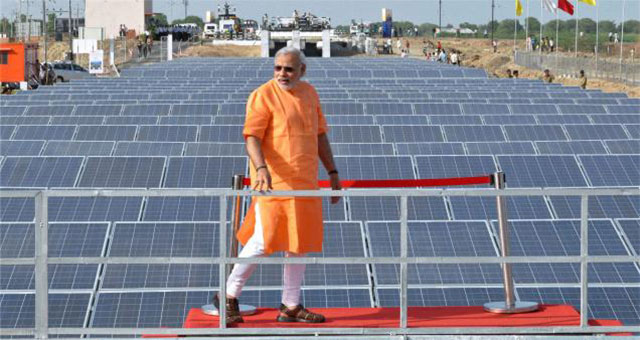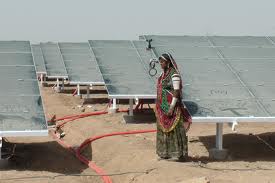Updated on: 2nd June 2016
List of Solar Panel/ Module Manufacturing Companies in India
1) Tata Power Solar
Headquartered in Bangalore, Tata Power Solar has a 200 MW and 180 MW of module and cell manufacturing facility located in Bangalore. The company is engaged in manufacturing and EPC services. The company is trying to increase solar awareness in the remote parts of India. The company has commissioned 175 MW of EPC projects, 43 MW of solar rooftop projects, and exported 600 MW of modules till date. Tata Solar has a presence in industrial, commercial, both on-grid and off-grid solar projects and residential. The company is backed by the Tata Group in India. The solar panels consist of 36, 60 and 72 six inch multi-crystalline cells and have a 25-year warranty, with power range varying from 0.3 W to 305 W. The modules come in two makes:
i) Standard modules – TP250, TP300 and TS 250 series, ideal for rooftop installations and utility-scale projects.
ii) Specialty modules – Tata Solar Gold and Platinum series, ideal for indoor, outdoor, street, billboard lighting, remote telecom sites and standalone systems for the home.
The company has also executed certain projects in UK.
Compare and buy the best selling Solar Panels in India here.
2) Su-Kam
Su-Kam is considered to be India’s largest power solutions company. The company is the largest solar inverter manufacturer in the country. Su-Kam also has a presence in the residential EPC market in India. Su-Kam Solar panels come in a wide range from 10W – 250W. These panels come with 25 years warranty and are designed to withstand the extreme weather conditions in India. These panels are shock resistant with thick iron glass and an anodized aluminium frame. They can generate a maximum of ~16V-30V, depending upon the wattage.

3) Vikram Solar
Headquartered in Kolkata, Vikram Solar is a manufacturer of PV solar modules. The manufacturing plant has a 150 MW installed capacity in West Bengal. They manufacture polycrystalline modules and are available in six series under the name Eldora. Read more details here.
i) Micro series – 18/36 celled having applications in Home and Street Lighting
ii) Mini, Core, Ultima and Grand series – 48, 54, 60 and 72- celled respectively, used in On-grid rooftop domestic and commercial systems & Off-grid residential systems.
4) Waaree Solar
The company has a 250 MW solar panel manufacturing unit in Surat, having a presence across the solar power value chain. These are monocrystalline/ multicrystalline silicon solar panels. The company has an experience with solar thermal and EPC utility grid projects. Waaree manufactures a wide range of solar products ranging from solar modules, to solar water pumps and rooftop solutions. Read more here.
i) Surya series – with either 18 cells or 36 cells. These modules can be used in solar chargers, solar gadgets, solar lanterns and other home lighting solutions.
ii) Arka series – with 36 cells. These modules can be used in home lighting solutions, street lighting, water pump and off grid systems.
iii) Ravi Series – with 36 cells or 72 cells. These modules can be used in home lighting solutions, street lighting, water pump and off grid systems.
iv) Marica series – either 54 cells or 60 cells, used in used in off grid and grid tied systems.
v) Aditya series – 60 cells, 72 cells or 80 cells modules, used in utility scale, off grid and grid tied systems.
vi) Color & flexible series – 36 celled modules and BIPV modules.
5) Indo Solar
Is a manufacturer of solar cells and modules, located in Greater Noida Uttar Pradesh. The current manufacturing capacity is 450 MWp, with an average efficiency rating of 17.4%. They manufacture 36 celled polycrystalline silicon panels, with 5 years workmanship warranty. Their modules are of two types:
ISL 40W – 100W and ISL 120W – 150W.
6) Loom Solar
Loom Solar is a fully integrated solar module manufacturing company with an annual manufacturing capacity of 100 MW. The company manufactures both polycrystalline (10-345 W) and monocrystalline (50-340 W) modules. These panels come with a 25-year limited warranty on 80% power output and 10-year limited warranty on materials or workmanship. Some features of the solar panels manufactured by Loom Solar include positive power tolerance, usage of 5 busbar technology, low-light performance and are PID resistant.
Other international suppliers in India
Besides these eminent producers in India, there are certain international players gaining traction in India. First Solar a leading thin film manufacturer has captured a sizeable portion of the Indian solar market. The hot climate of India is ideal for its thin-film modules. According to Bridge to India report, Trina Solar and Canadian Solar were top-selling international brands in India in 2014. Others like Jinko Solar, ReneSola and Yingli Green Energy are also selling panels in India. These international panels are of good quality and also less expensive than the domestic ones. The average selling price in India is still ~60 cents per watt, whereas Jinko Solar panels will be available to you at approximately 40-45 cents per watt. However, with India’s new solar target of achieving 100 GW of solar power by 2022 and the Prime Minister’s “Make in India” initiative, we hope to see more of such India panels in the market.
Other Local Suppliers in India
In addition to the list above, there are numerous small companies also engaged in the manufacturing and supplying of solar panels in India. Look into this space to find out more about the state wise solar panel distributors present in India.
Note: Interested companies may also list with us by an email to greenworldinvestor@gmail.com or by entering their details in the Business leads section above on the website, for getting business leads.




